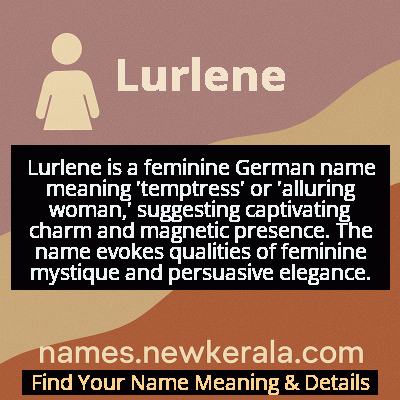Lurlene Name Meaning & Details
Origin, Popularity, Numerology Analysis & Name Meaning of Lurlene
Discover the origin, meaning, and cultural significance of the name LURLENE. Delve into its historical roots and explore the lasting impact it has had on communities and traditions.
Name
Lurlene
Gender
Female
Origin
German
Lucky Number
6
Meaning of the Name - Lurlene
Lurlene is a feminine German name meaning 'temptress' or 'alluring woman,' suggesting captivating charm and magnetic presence. The name evokes qualities of feminine mystique and persuasive elegance.
Lurlene - Complete Numerology Analysis
Your Numerology Number
Based on Pythagorean Numerology System
Ruling Planet
Venus
Positive Nature
Harmonious, responsible, caring, and artistic.
Negative Traits
Overly idealistic, superficial, possessive, or jealous.
Lucky Colours
Pink, turquoise.
Lucky Days
Friday.
Lucky Stones
Diamond, turquoise.
Harmony Numbers
2, 3, 9.
Best Suited Professions
Artists, musicians, teachers, healthcare workers.
What People Like About You
Warmth, nurturing nature, artistic flair.
Famous People Named Lurlene
Lurlene McDaniel
Author
Bestselling young adult novelist known for inspirational novels about teenagers facing adversity
Lurlene Burgess
Actress
American stage and film actress known for regional theater and character roles
Lurlene Wailes
Community Leader
Influential organizer and advocate for women's education in rural communities
Name Variations & International Equivalents
Click on blue names to explore their detailed meanings. Gray names with will be available soon.
Cultural & Historical Significance
The name's evolution reflects changing attitudes toward feminine identity, moving from purely mythological associations to embodying a more contemporary ideal of feminine strength combined with traditional appeal. Its usage patterns mirror the cultural shifts in how women's roles were perceived, balancing traditional femininity with emerging independence. In American culture, particularly in Southern states, Lurlene became associated with a certain type of gracious, strong-willed woman who maintained traditional values while navigating modern society. The name's decline in popularity since the 1970s corresponds with broader social changes and the rise of more diverse naming practices.
Extended Personality Analysis
Women named Lurlene are often perceived as possessing a natural charisma and magnetic presence that draws others to them. They typically exhibit a blend of traditional feminine grace with underlying strength and determination. Their 'temptress' quality manifests not necessarily in romantic contexts, but rather in their ability to captivate attention through intelligence, wit, and emotional depth. Lurlenes are often described as having excellent social intuition, able to read people and situations with remarkable accuracy.
This combination of social intelligence and personal magnetism often makes Lurlenes memorable figures in their social and professional circles, leaving lasting impressions on those they encounter. They tend to be persuasive communicators who can influence others through charm rather than force, making them effective in leadership roles that require diplomacy and relationship-building. Their strength lies in their ability to balance traditional feminine qualities with modern independence, creating a unique personal style that is both approachable and commanding. While they may appear gentle and accommodating, Lurlenes typically possess strong convictions and the determination to pursue their goals with quiet persistence.
Modern Usage & Popularity
In contemporary times, Lurlene has become a relatively rare name, experiencing its peak popularity during the mid-20th century. Current usage trends show it appearing primarily as a family name passed through generations rather than a choice for new births. The name maintains a nostalgic quality, often associated with grandmothers or great-grandmothers in Southern and Midwestern American families. While not commonly chosen for newborns today, it occasionally appears as a middle name honoring family heritage. Social Security Administration data indicates the name has fallen out of the top 1000 names since the 1970s, reflecting changing naming trends toward shorter, more modern-sounding options. However, its uniqueness in the modern era gives it a distinctive charm for parents seeking vintage names with character and history, and it may experience a minor revival as part of the broader trend toward rediscovering traditional names.
Symbolic & Spiritual Meanings
Symbolically, Lurlene represents the power of feminine allure combined with inner strength. The name evokes images of flowing water and natural magnetism, drawing from its Germanic roots connected to the Lorelei legend. It symbolizes the ability to influence and attract through subtle means rather than overt power, representing the strength found in grace and persuasion. Metaphorically, Lurlene suggests a bridge between traditional femininity and modern independence, embodying the idea that true power often lies in the ability to charm and persuade rather than command. The name carries connotations of mystery and depth, suggesting a person whose true nature reveals itself gradually, like the unfolding petals of a flower. It represents the enduring appeal of feminine mystique in an age of transparency and immediate gratification, serving as a reminder that some forms of influence work quietly but effectively beneath the surface.

